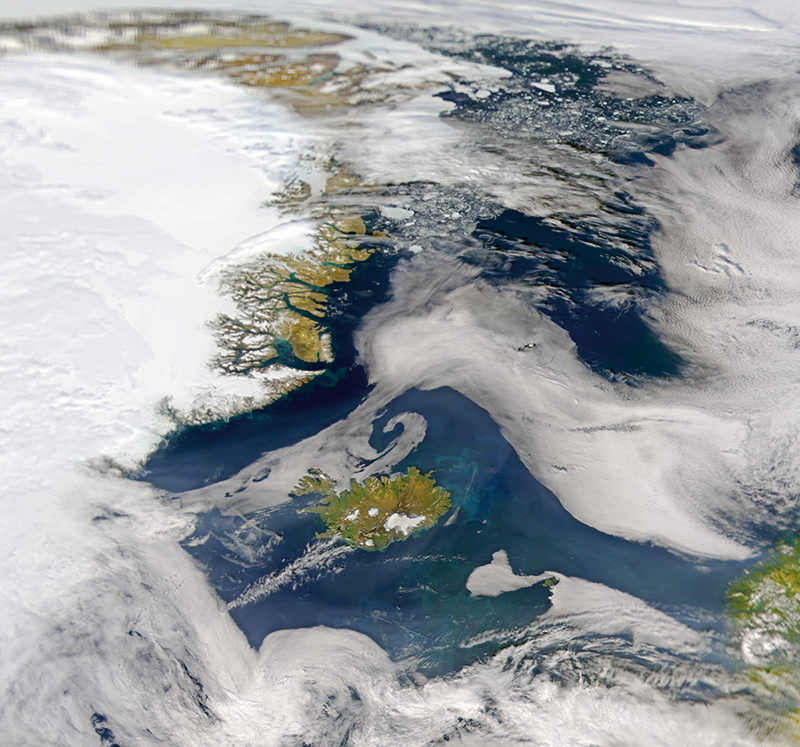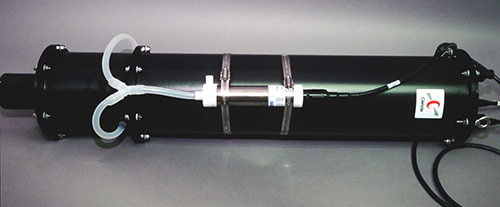
FLIPPER: Validation for Remote Ocean Imaging
Originating Technology/NASA Contribution
In order to better understand our solar system and the ways it supports life, scientists and researchers at NASA study the planets. Of course, one of the planets on which NASA focuses most of its research is the Blue Planet, Earth, since this is the only one currently known to support life; and it is also, for all practical purposes, the most accessible. These scientists and researchers know that one of the determining factors in the planet’s ability to support life is the same factor that makes the Blue Planet blue: water. Therefore, NASA researchers have a focused interest in understanding Earth’s oceans and their ability to continue sustaining life.
A critical objective in this study is to understand the global processes that control the changes of carbon and associated living elements in the oceans. Since oceans are so large, one of the most widely used methods of this research is remote sensing—using satellites to observe changes in the ocean color that may be indicative of changes occurring at the surface. Major changes in carbon are due to photosynthesis conducted by phytoplankton, showing, among other things, which areas are sustaining life. Although valuable for large-scale pictures of an ocean, remote sensing really only provides a surface, and therefore incomplete, depiction of that ocean’s sustainability.
True and complete testing of the water requires local testing in conjunction with the satellite images in order to generate the necessary algorithm parameters to calculate ocean health. For this reason, NASA has spearheaded research to provide onsite validation for its satellite imagery surveys.
Partnership
Under a NASA Small Business Innovation Research (SBIR) grant with Stennis Space Center, Ciencia, Inc., of East Hartford, Connecticut, developed the Fluorescence Lifetime Profiler of Photochemical Efficiency in Real-time, or FLIPPER, to assist in understanding the global processes controlling the fluxes of carbon and associated biogenic elements in the oceans. Biologists and oceanographers benefit from this new device that provides real-time data of water properties essential to understanding water on a global scale. Now being used to monitor the Earth’s oceans, the results of this technological partnership are also finding homes in applications as broad as agricultural analysis and pharmaceutical manufacturing.
Dr. Salvador Fernandez, president of Ciencia, Inc., praises the NASA SBIR program and how it has helped bring the technology to fruition. “This project is exemplary of the goals of the SBIR program,” he said. “On one hand, we have been able to provide NASA with a unique technology, essential to meeting its mission, while at the same time creating core technology that [is enabling] us to develop new products for very different applications, such as drug discovery and process analysis in the pharmaceutical industry.”
While not all of these goals have been fully realized, they are still in the works and quite near fruition; the NASA technology and funding will help them come to life, while, in the meantime, the oceanographic surveying tool, FLIPPER, is already advancing the study of the Earth’s oceans.
Product Outcome
FLIPPER is a fully submersible oceanographic vertical profiler for in situ, or onsite, measurements. It is being assessed by NASA researchers and the oceanographic research community to determine its ability to monitor photosynthetic parameters in marine phytoplankton for oceanographic, estuarine, limnological, and riverine research; environmental monitoring of phytoplankton populations; ocean optical properties research; and studies of fisheries and ecosystems.
FLIPPER is an effective vertical profiler for these types of research. Other vertical profiling methods can be inaccurate and confusing. Instruments based on chlorophyll fluorescence intensity, for example, cannot provide accurate information on chlorophyll concentration; the quantum yield of chlorophyll fluorescence is variable, and intensity alone does not provide any information about photosynthesis status. FLIPPER permits, for the first time, direct determination of in vivo chlorophyll fluorescence quantum yield in situ. This is an essential parameter in the study of ocean and coastal ecosystems, one that has been shown to be inversely related to the rate at which phytoplankton biomass is formed.
The concentration of chlorophyll in the oceans presents a major detection challenge, because in order to obtain accurate values of photosynthetic parameters, the intensity of light used to excite fluorescence must be kept very low so as not to disturb the photosynthetic system. Several innovations in fluorometric instrumentation were made in order to make it possible for FLIPPER to reach the required low-detection limit. These innovations include a highly efficient optical assembly with an integrated flow-through sample interface, and a high-gain, low-noise electronic detection subsystem.
The instrument also incorporates means for self-calibration during operation and electronic hardware and software for control, acquisition, and analysis of data and communications. The electronic circuitry is highly miniaturized and designed to minimize power demand. The instrument is housed in a package that can withstand the water pressure at the maximum depth of 300 meters. All of these innovations allow FLIPPER to perform as other ocean-profiling devices cannot.
Within FLIPPER, a light-emitting diode excites fluorescence in the sample flow cell, which is placed at one focal point of an ellipsoidal reflector. A photomultiplier tube is placed at the other focal point. This optical arrangement enables highly efficient collection of fluorescence emitted over all polar directions. The excitation is modulated at a specific frequency, and the phase shift between
the excitation light and the emitted fluorescence is measured by a detection method in which the signal is down-converted. The fluorescence lifetime can be computed from the known relationship among the fluorescence lifetime, phase shift, and modulation frequency.
In operation, the instrument measures fluorescence intensity and lifetime repeatedly, according to a schedule established during an instrument set-up process, in which the instrument is connected to a host computer. Once programmed, the instrument is disconnected from the computer and remains in an inactive, quiet state as it is placed in the ocean. The measurement process is started by use of a magnetically actuated switch.
Measurements taken by the instrument are recorded in a memory module that can hold data from more than 28,000 measurements. The set of data from each measurement is time-stamped and includes a pressure/depth datum. Switching the instrument off terminates the measurements and prepares the instrument for the next series. At the end of a series of measurements, the instrument is reconnected to the host computer and the measurement data are uploaded from the instrument’s memory module to the computer. These data provide researchers with never-before-seen accuracy.
The development of FLIPPER is an important advance for biological oceanographic research, for phytoplankton ecology studies, and for ground truth of primary production estimates made from satellite ocean color measurements, but the technologies developed for these experiments are rapidly finding uses in other fields as well.
Based on the core technological development for FLIPPER, Ciencia has entered into two commercialization agreements that represent non-equity investments in research and development and engineering services directed at new product creation.
Ciencia has received a significant investment from HTS Biosystems, Inc., of Hopkinton, Massachusetts, for a product development effort that will incorporate frequency-domain technology developed under the NASA work into instrumentation for drug discovery.
In addition, Ciencia has also entered into another product development agreement with an international company for the making of a sensor for online process analysis of powder mixtures in the pharmaceutical industry. A feasibility study funded by this commercialization partner has been completed, and design of a system for beta site testing is underway.
This research has generated a significant amount of interest and already has investors clamoring to get involved. Additional applications include precision farming; noninvasive clinical instrumentation and analytical instrumentation for food safety testing; environmental analysis; and noninvasive, real-time, online processing monitoring for food manufacturing.
Ciencia recently signed an agreement with Global Imaging of Japan, based in Chiba, that now controls international distribution of FLIPPER.

FLIPPER is a fully submersible oceanographic vertical profiler for onsite measurements. The electronic circuitry is designed to minimize power demand, and the instrument housing can withstand water pressure at a maximum depth of 300 meters. The instrument also incorporates means for self-calibration, and highly miniaturized electronic hardware and software for control, acquisition, and analysis of data and communications.

The many shades of blue and blue-green in this image indicate that marine plant life (phytoplankton) is in full bloom around Iceland. This image is from NASA’s Sea-viewing Wide Field-of-view Sensor (SeaWiFS) Project, whose goal is to provide quantitative data on global ocean bio-optical properties to the Earth science community.













